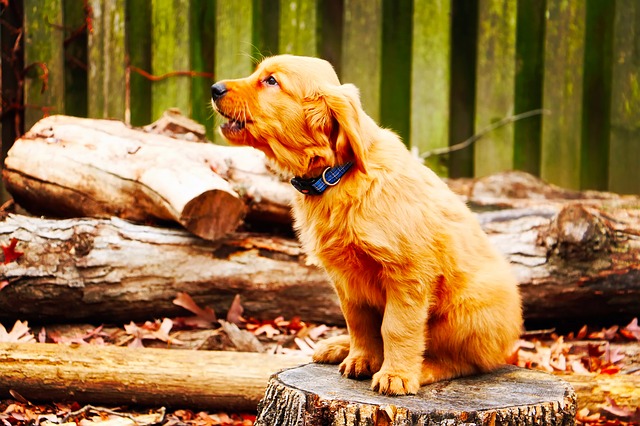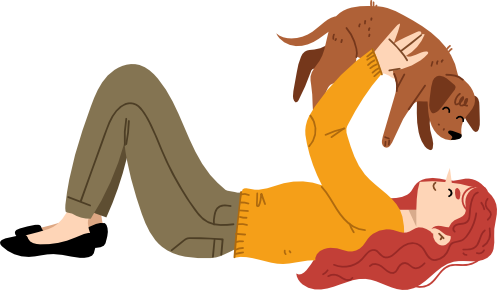I have treated cases of separation anxiety in all types of dogs―young, old, those who have only had one family, those who have had many.
Separation anxiety can manifest in many ways. Some of the more prominent and problematic symptoms of distress caused by separation anxiety are:
- Destruction of items in your home
- Self-harm
- Urination or defecation
- Pacing
- Vocalization like barking, howling, or whining
- Drooling and panting
The one thing I can tell you for certain, is that it can be debilitating for your family and it can be incredibly distressing for your dog.
Many factors can contribute to your dog’s separation anxiety.
Did I Do Something to Cause My Dog’s Separation Anxiety?
While there is likely a genetic component to most dog’s separation anxiety, there are some common mistakes that don’t help. Here are some common reasons why your dog might have developed separation anxiety:
- Not taking the proper steps to teach a puppy it’s ok to be alone. Getting your puppy used to being left alone in a very slow, systematic, and positive manner is key to successfully teaching your puppy independance. Trainers call this process conditioning. It can be quite stressful for a puppy to leave the company of mom and siblings. Suddenly they find themselves in a new human family, with new human rules! Often, puppies go from never being left alone to being left alone for eight or more hours per day. No wonder this stresses them out!
- Being left alone too much. Of course everyone has to make a living. Our lifestyle might dictate how long we are away during the day―from work, to evening activities, and errands. This can often be upwards to 10-12 hours a day in some cases. Dogs are social animals, and this is just too long to be left alone!
- Re-homing. As you can imagine, dogs who are bounced around from home to home can often experience anxiety when left alone. It is also possible that more dogs with separation anxiety are relinquished due to their behaviour. Adopting may increase the potential that your new dog could have some level of separation anxiety.
- Sudden change in routine. New partner, new baby, new job, new house. These things all affect your dog, too. It can also disrupt their usual walk/sleep/eat/play routine, and this can be worrisome and upsetting to some dogs creating or exacerbating anxiety.
- Moving from a shelter and into a home. Akin to rehoming, living in a shelter is a very different, and often scary place for some dogs. Whether their past history is known or not, this is certainly not an ideal residence for any dog.
- Losing a family member. Maybe Laura is off to university, or there is a divorce or death in the family. This can trigger symptoms of separation anxiety, or can exacerbate a mild case of anxiety. Often multiple factors are at play, including the above stated change in routine, the human emotion, and I am sure, missing someone they were once close with.
- Leaving the litter too early. There is some evidence to suggest that leaving the litter before 60 days can predispose a dog to developing separation anxiety.
- Genetics. That’s right! Research suggests your dog may have been born with a predisposition to separation anxiety. Although preventative measures can be helpful, they do not always result in a dog who is happy to be left home alone.
Regardless of how it started, if you have a dog who is suffering from separation anxiety, there is hope! For starters, we are offering a six week online course to help you.
Can I Prevent Separation Anxiety Before it Becomes a Problem?
Sometimes, yes! And although some of the items listed above are unavoidable, we can still help to prevent separation anxiety from happening later on down the road.
Going back to my first point, properly conditioning your new puppy or new dog to being alone is the most important step to prevention.
We must remember, there is an adjustment period for any new dog, be it a puppy coming straight from their litter, or a newly adopted adult dog.
As a rule of thumb, I always say it is going to be a minimum of three weeks before your new dog begins to adjust to their new environment.
How Can I Prevent Separation Anxiety?
There are some things we can do to help our new puppy or adult dog adjust to their new life, and to being left alone. The best we can do is try to prevent separation anxiety before it starts.
- Be there. During this adjustment period, it is ideal if you can stay home with your new dog as much as possible. This allows you to introduce departures slowly and allows them time to bond with you and learn about their new environment.
- Short departures. This should be gradual and for small chunks of time. If you go from being with them around the clock to being away for eight hours a day, it can cause a lot of stress for your dog.
- Avoid dramatic “goodbyes” and “hellos.” As hard as it is not to, fostering that very excited behavior when you come home is not helping. Say hello once they are calm and ready, making it no big deal that you left in the first place, or that you’re home now.
Likewise, making a big scene about leaving only makes your dog wonder what’s up. You don’t need to sneak out the door, but ask them to enter their kennel or area, give them a delicious cheese and turkey stuffed Kong, and a quick “see ya later” is all that’s needed.
- Take this time to introduce the kennel or confinement area. You probably will not need this forever, but new puppies absolutely need a confined space! This could be crates, exercise pens, or the use of baby gates. Make it a fun game to go into this space (see how we teach “Go to Place” here). Try to not only use this space for departures, never use it for punishment, and always provide their favorite chew items or interactive toys (check out our favorites below).
- Teach independence. A great way to teach your dog to be independent and to have impulse control, is by teaching them “place.” This behavior teaches your dog or puppy that they can be calm and independant of you and other distractions in their environment.
- Enrichment and interactive toys. This is important all of the time, throughout the day and evening-not just when you are away. But teaching your dog that departures mean they get a hollow toy (I like buffalo horns) stuffed with peanut butter, cheese, and liver will make departures positive and maybe even exciting! Remember to rotate the items you
use, and include a variety ofhigh value stuffing. We recommend giving your dog a daily Easter egg hunt with several toys as part of your dog-friendly morning routine.
- Break up long outings. If you have several errands to do, try to break it up so that you are only leaving for short amounts of time. Even better, take your dog with you to dog-friendly spaces!
If you have progressed to the stage of leaving your dog at home all day while you are at the office, try hiring a dog walker. Alternatively, come home for lunch and break up the long absence by going for a walk or doing a training session.
You could also try dog day care, if your dog enjoys that environment (not all dogs thrive in day care, so keep that in mind).
Separation anxiety is not always avoidable, but give your dog the best chance to adjust to being home alone. You will be glad you did. And so will your dog!
Happy training!

